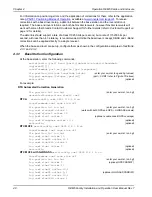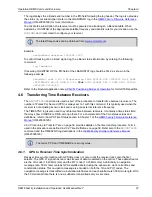
Operation OEM6 Cards and Enclosure
Chapter 4
OEM6 Family Installation and Operation User Manual Rev 7
57
The log displays the L-Band serial number in the fifth field following the log header. The log also provides
the status of your subscription. Refer to the LBANDINFO log in the
OEM6 Family Firmware Reference
(OM-20000129) for more information.
To activate the subscription, the receiver must be powered and tracking an L-Band satellite. When
advised by OmniSTAR of the appropriate satellite frequency and data link rate for your location, use the
ASSIGNLBAND
command to configure your receiver.
Example:
assignlband omnistar 1557855 1200
To confirm tracking of an L-Band signal, log the L-Band status information by entering the following
command:
log lbandstat
If receiving OmniSTAR HP, the fifth field of the LBANDSTAT log should be 00c2, as shown in the
following example:
lbandstat com1 0 81.0 finesteering 1596 235136.000 00000000 d1c2 5968
<1557854678 48.98 1098.9 0.00
00c2
0000 153860 545 0 0000 0201 154019
68000000 00000000
Refer to the NovAtel application note
APN-051 Positioning Modes of Operation
for OmniSTAR specifics.
4.6
Transferring Time Between Receivers
The
ADJUST1PPS
command is used as part of the procedure to transfer time between receivers. The
number of Pulses Per Second (PPS) is always set to 1 with this command. It is typically used when the
receiver is not adjusting its own clock and is using an external reference frequency.
The TIMESYNC log is also used to synchronize time between receivers. It contains a time status field
that may show COARSE or FINE, among others. For a complete list of the time status values and
definitions, refer to the GPS Time Status section in Chapter 1 of the
OEM6 Family Firmware Reference
(OM-20000129).
4.6.3 Procedures to Transfer Time
provides details on the time transfer procedure. Terms
used in the procedure are defined in
. Refer also to the
ADJUST1PPS
command and the TIMESYNC log descriptions in the
OEM6 Family Firmware Reference Manual
(OM-20000129)
.
4.6.1
GPS to Receiver Time Synchronization
Receiver time synchronization with GPS time does not occur until the receiver locks onto the first
satellite. The GPS L1 signal has two main streams of data modulated on the carrier. These data streams
are the C/A code (1.023 MHz rate) and the P(Y) code (10.23 MHz rate). Additionally, a navigation
message (at a 50 Hz rate) contains GPS satellite data including the ephemeris, clock corrections and
constellation status. This navigation message is encoded on both the C/A and P(Y) codes. The
navigation message is transmitted via individual subframes and each subframe is 300 bits in length. With
the 50 Hz data bit rate there is a new subframe transmitted every six seconds.
The latest frequencies can be obtained from:
The terms PPS and TIMEMARK are synonymous.






























